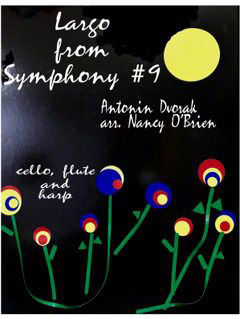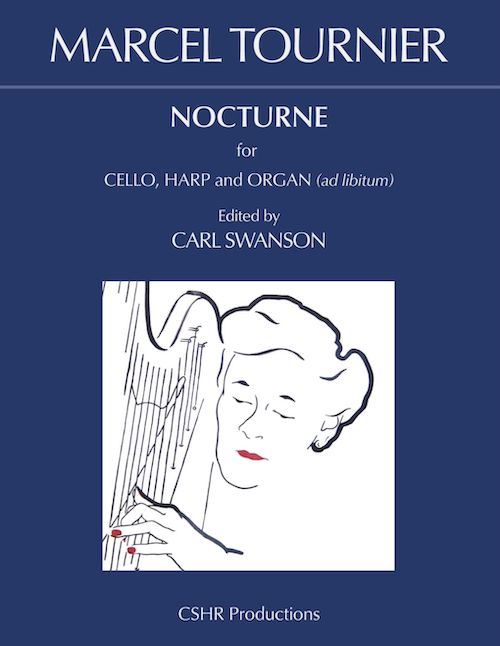




New chamber music arrangements include (from l. to r.): an original work by Barbara Neumuller, three arrangements for cello, flute, and harp by Nancy O’Brien, and Tournier’s Nocturne for cello, harp, and organ.
One of the nicest chamber combinations with the harp is flute and cello. Lyon & Healy Publications presents some appealing, downloadable additions to the repertoire by some capable arrangers.
“Life is a River” is an original piece by Barbara Neumuller. It is a little over six minutes in length and suitable for the intermediate level. The harp part includes the flute and cello parts and is eight pages long.
There are recordings on YouTube and Harp.com, but they differ somewhat from the printed music. However, it still has the same calming, forward motion—never urgent, but imparting a constant energy. There is a nice balance among the instruments with the flute largely supplying the melody and the cello offering support.
The harp begins alone for four measures and continues to play throughout, primarily in eighth notes that drives the music ever forward. Perhaps this feeling of motion represents a river flowing? The key changes several times, maybe symbolizing different phases of life? The two hands are often going in opposite directions, making it a little trickier to play, especially with the frequent pedal changes. Unfortunately, none of the pedal changes are notated and that would have been very helpful. Fortunately, some of the left hand notes can be omitted without really being missed. You can’t hear all the left hand notes on the recording anyway.
This music would be useful in a variety of settings from a background music gig to a concert. Listen to it and see if it appeals to you.
Nancy O’Brien has arranged some music for this chamber trio by several late 19th and early 20th century composers. O’Brien’s biography tells us she has always been drawn to classical music with an ethnic edge or ethnic tunes arranged for a classical trio. She offers some trio music for flute, harp, and cello by Bartók, Dvořák, and Fauré.
“Evening in the Village” by Béla Bartók is just four pages. It has several time changes. It starts out slowly and rubato, but becomes energetic and lively until the last page. No fingering is suggested, but it is not difficult, and an intermediate player should find this almost sight-readable.
There are several errors in “Largo” from Symphony No. 9 by Antonin Dvořák. It begins with incorrect pedal markings. The music is in D-flat, so there is already an A-flat and it doesn’t need to be marked or moved. Maybe it was intended to be an enharmonic substitution for the G-sharp which could then be eliminated? The E and B pedals need to be pre-set to natural for the very first chord, but this is not indicated. The pedal marking errors continue throughout the first four measures. Accidental markings are missing in measures 22 and 23 where the D-flat is raised to natural, then back to flat, and back to natural. The pedal markings indicate this change, but the note does not. In fact, it appears to be a tie. There should also be a G natural pedal marking. There are several more measures with incorrect pedal markings beginning at measure 44.
These errors aside, it is a very playable arrangement. The corrections should be easy to fix for this downloadable arrangement.
“Mai” by Fauré is a little gem. It is a sweet melody in 3/4 and only about three minutes long. The cello plays mainly dotted half notes providing a rich, seamless bass line. The harp plays mostly ascending and descending eighth notes lending a gentle rocking action throughout. The flute has the melody.
There are frequent pedal changes and they are notated in the middle of the staff. The A-sharp in measure 31 is not marked, but the B is already flat and probably meant to be a substitution. O’Brien does indicate an enharmonic substitution in measure 47 where the F (which is already natural) is written in parentheses as a substitute for the E-sharp. This charming piece is almost sight-readable for the intermediate level player.
All three of O’Brien’s arrangements can be heard and downloaded on Harp.com. All the pieces include the flute and cello parts on the harp score as well as a separate part for flute and cello.
And speaking of gems, CSHR, Inc. has published an absolutely gorgeous composition for cello, harp, and organ by Marcel Tournier. Tournier was a prolific composer with approximately 100 compositions to his credit. This piece is dedicated to Tournier’s teacher, Alphonse Hasselmans, and was written in 1909. The music has been edited by Carl Swanson.
Swanson’s editing is so thorough that you won’t have to mark anything. All pedal changes are clearly marked in the center of the staff in large font that cannot be missed. He provides frequent pedal charts as well as regular reminders of the key signature (e.g., 4b or 6#). Fingering is provided whenever it might not be obvious and stem direction indicates which hand should be used. He also includes definitions of the French musical terms used in the score.
The harp part requires clean, even playing of fast arpeggios, delicately rolled lush chords, and frequent, fast pedal changes. The cello plays the beautiful melody. The organ part is optional and never overpowers the strings.
It is available on Harp Column Music (HCM) and you can download the complete score or individual parts. You can also hear a lovely rendition of this music on HCM. Swanson rates the level of difficulty as intermediate and cautions that it is not as difficult as it sounds (or looks). However, there are some tricky sections and the pedal work is definitely not easy. Nevertheless, it is well worth the effort to add this engaging piece to your repertoire. •
Jan Jennings has been the music review editor for Harp Column since 1993. She is an active freelancer and teacher, and is the author of The Harpist’s Complete Wedding Guidebook and Effortless Glissing. Email her at
mail@harpbiz.com.






